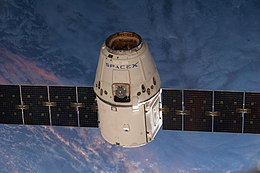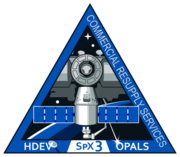SpaceX CRS-3

SpaceX CRS-3 Dragon spacecraft approaching ISS on 20 April 2014
|
|
| Mission type | ISS resupply |
|---|---|
| Operator | NASA |
| COSPAR ID | 2014-022A |
| SATCAT no. | 39680 |
| Mission duration | 30 days |
| Spacecraft properties | |
| Spacecraft type | Dragon |
| Manufacturer | SpaceX |
| Start of mission | |
| Launch date | 18 April 2014, 19:25:21 UTC |
| Rocket | Falcon 9 v1.1 |
| Launch site | Cape Canaveral SLC-40 |
| Contractor | SpaceX |
| End of mission | |
| Disposal | Recovered |
| Landing date | 18 May 2014, 19:05 UTC |
| Orbital parameters | |
| Reference system | Geocentric |
| Regime | Low Earth |
| Semi-major axis | 6,700 km (4,200 mi) |
| Eccentricity | 0.0015 |
| Perigee | 312 km (194 mi) |
| Apogee | 333 km (207 mi) |
| Inclination | 51.65 degrees |
| Period | 90.97 minutes |
| Epoch | 18 April 2014 |
| Berthing at ISS | |
| Berthing port | Harmony nadir |
| RMS capture | 20 April 2014, 11:14 UTC |
| Berthing date | 20 April 2014, 14:06 UTC |
| Unberthing date | 18 May 2014, 11:55 UTC |
| RMS release | 18 May 2014, 13:26 UTC |
| Time berthed | 27 days, 21 hours, 49 minutes |
| Cargo | |
| Mass | 2,089 kg (4,605 lb) |
| Pressurised | 1,518 kg (3,347 lb) |
| Unpressurised | 571 kg (1,259 lb) |
|
|
|
SpaceX CRS-3, also known as SpX-3, was a cargo resupply mission to the International Space Station, contracted to NASA, which was launched on 18 April 2014. It was the fifth flight for SpaceX's uncrewed Dragon cargo spacecraft and the third SpaceX operational mission contracted to NASA under a Commercial Resupply Services contract.
This was the first launch of a Dragon capsule on the Falcon 9 v1.1 launch vehicle, as previous launches used the smaller v1.0 configuration. It was also the first time the F9 v1.1 has flown without a payload fairing, and the first experimental flight test of an ocean landing of the first stage on a NASA/Dragon mission.
The Falcon 9 with CRS-3 on board launched on time at 19:25 UTC on 18 April 2014, and was grappled on 20 April at 11:14 UTC by Expedition 39 commander Koichi Wakata. The spacecraft was berthed to the ISS from 14:06 UTC on that day to 11:55 UTC on 18 May 2014. CRS-3 then successfully de-orbited and splashed down in the Pacific Ocean off the coast of California at 19:05 UTC on 18 May.
The launch was notionally scheduled by NASA, as of November 2012, to be no earlier than 30 September 2013, with berthing to the station occurring three days later on 2 October 2013.
By March 2013, the launch was scheduled by NASA for no earlier than 28 November 2013, with berthing to the station occurring three days later on 1 December 2013. By August 2013, the launch date had been moved to no earlier than 15 January 2014, but by October it was moved to 11 February. As of 23 January, the launch was rescheduled again to 1 March 2014, and then rescheduled to 16 March in early February. The several delays—from the nominal December 2013 date that had been in place since early 2013—have been mostly due to limited berthing windows in the ISS Visiting Vehicle schedule, and delays to both Orbital's Cygnus and SpaceX's Dragon resulted from the December 2013 cooling issue on the ISS which required several spacewalks to mitigate.
...
Wikipedia

